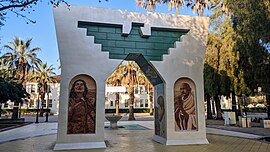| Arch of Dignity, Equality, and Justice | |
|---|---|
 | |
| Artist | Judy Baca |
| Year | 2008 |
| Medium | Mosaic |
| Movement | Chicana art |
| Subject | Cesar Chavez, Dolores Huerta, Mahatma Gandhi, Robert Kennedy, two unnamed farmworkers |
| Dimensions | 7.6 m (25 ft) |
| Location | San Jose, California, United States |
| 37°20′07″N 121°52′53″W / 37.3353°N 121.88131°W | |
| Owner | San Jose State University |
The Arch of Dignity, Equality, and Justice, commonly referred to as the Cesar Chavez Arch, is an art installation and monument consisting of a pearlescent plaster arch in the style of a Mayan corbelled arch and includes five Venetian tile mosaics.[1] It was created by American artist Judy Baca, and is installed along the Paseo de César Chávez on the San Jose State University campus, in San Jose, California, United States. The four front-facing mosaics feature portraits of Dolores Huerta, Mahatma Gandhi, and two unnamed farmworkers, while the mosaic on the underside of the arch features Cesar Chavez encountering Robert Kennedy.[2]
The top of the arch is adorned with a stacked glass eagle in the style of the United Farm Workers well-known logo.[3] Richard Chavez, César Chávez's brother, originally designed the black Aztec eagle insignia that became the symbol of the National Farm Workers Association and the UFW.[4]

